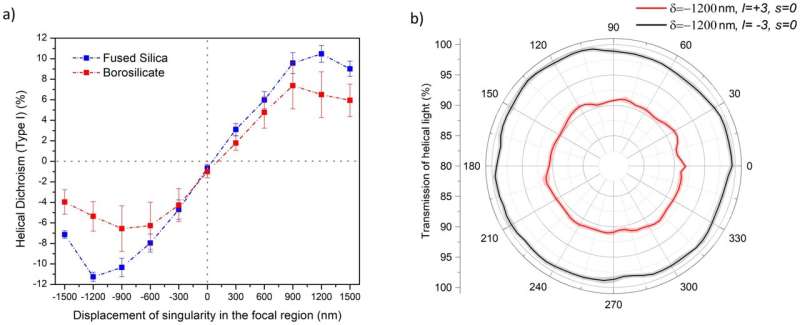This article has been reviewed according to Science X's editorial process and policies. Editors have highlighted the following attributes while ensuring the content's credibility:
fact-checked
peer-reviewed publication
trusted source
proofread
Scientists reveal how light behaves in formless solids

For a long time, it was thought that amorphous solids do not selectively absorb light because of their disordered atomic structure. However, a new uOttawa study disproves this theory and shows that amorphous solids actually exhibit dichroism, meaning that they selectively absorb light of different polarizations.
Researchers at the University of Ottawa have found that using helical light beams in disordered solids reveals this dichroism. This discovery contradicts prior beliefs and provides an opportunity to alter the way light interacts with these materials by changing the properties of the light itself.
These findings also underscore the importance of short-to-medium-range order within disordered solids in influencing how materials react to light. The study, titled "Intrinsic dichroism in amorphous and crystalline solids with helical light," is published in Nature Communications.
Led by Professor Ravi Bhardwaj, who is a Department of Physics researcher who heads uOttawa's Extreme Ultrafast Photonics research group, and doctoral students Ashish Jain and Jean-Luc Begin, this year-long study was conducted in collaboration with professors Thomas Brabec and Paul Corkumat uOttawa's Advanced Research Complex (ARC).
"The research was conducted by employing helical light beams carrying orbital angular momentum to probe the optical properties of amorphous and crystalline materials," explains Professor Bhardwaj. "By utilizing a birefringent liquid crystal plate, called a q-plate, developed by Professor Karimi's group, we were able to produce designer light fields with twisted wavefronts that describe a corkscrew pattern."
This research has broad implications and challenges current beliefs about the optical characteristics of amorphous solids. It also presents opportunities to control a material's optical behavior by using helical light beams. These findings are significant for multiple fields, including materials science, optics, and chiroptical spectroscopy.
"Our team developed a new method to show that non-crystalline solids can exhibit helical dichroism, which means they react differently to light that twists in different directions," says Professor Bhardwaj. "The experimental evidence was complemented by theoretical models developed in collaboration with Professor Brabec, providing a comprehensive understanding of the observed phenomena."
"The helical light served as an indirect probe of short-to-medium-range order in disordered solids that extends up to 2 nm. Our research will aid efforts to understand the mysterious nature of amorphous materials," adds Ashish Jain and Jean-Luc Bégin.
This work significantly advances our understanding of the optical properties of solid-state materials. By demonstrating the existence of intrinsic dichroism in both crystalline and amorphous solids, this research paves the way for innovative applications and further exploration of the unique capabilities of helical light beams in probing and manipulating material properties.
More information: Ashish Jain et al, Intrinsic dichroism in amorphous and crystalline solids with helical light, Nature Communications (2024). DOI: 10.1038/s41467-024-45735-9
Journal information: Nature Communications
Provided by University of Ottawa




















